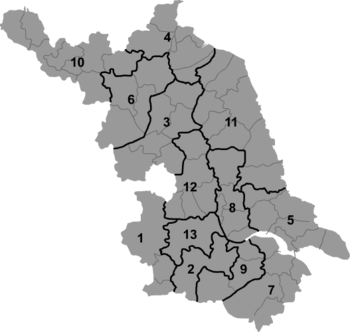Xiangshui County
| Xiangshui County 响水县 | |
|---|---|
| County | |
 Xiangshui Location in Jiangsu | |
| Coordinates: 34°12′54″N 119°48′14″E / 34.215°N 119.804°ECoordinates: 34°12′54″N 119°48′14″E / 34.215°N 119.804°E[1] | |
| Country | People's Republic of China |
| Province | Jiangsu |
| Prefecture-level city | Yancheng |
| Time zone | China Standard (UTC+8) |
| Website |
xiangshui |
Xiangshui County (simplified Chinese: 响水县; traditional Chinese: 響水縣; pinyin: Xiǎngshuǐ Xiàn; literally: "noisy water") is a coastal county under the administration of Yancheng, Jiangsu province, China. The northernmost county-level division of Yancheng, it borders the prefecture-level cities of Lianyungang to the northwest and Huai'an to the southwest. The county was founded in 1966, and has a population of 595,500. The county has 15 township-level divisions.
Administration
There are 12 towns are under the jurisdiction of Xiangshui County and they are:
- Xiangshui(响水镇)
- Shuanggang(双港镇)
- Xiaojian(小尖镇)
- Dayou(大有镇)
- Nanhe(南河镇)
- Chenjiagang(陈家港镇)
- Huangwei(黄圩镇)
- Zhangji(张集乡)
- Qitao(七套乡)
- Yunhe(运河镇)
- Liutao(六套乡)
- Laoshe(老舍乡)
Geography
On its northern territory, the Guanhe River, an inner river of Jiangsu, flows through from west to east until running into the Yellow Sea. The county owns 43 km of the coastal line, facing Japan and Korea by crossing the sea. Stunning local residents over years, tens of False Killer Whales from the Yellow Sea had swum back into its watergate as deep as 10 km. Covered by abundance of an aquatic plant species, shallow water lotus, the county is honored as a “Town of Shallow Water Lotus”.
Principal natural resources include its marine area and marshland. The county is currently the largest site for sea salt production in China.
Climate
Xiangshui county has an oceanic monsoon climate with humid changeable wind and distinct four seasons. The average temperature is 14°C with the hottest 38.7°C in July and the coldest -17°C in January. The raining season is from the middle of June to July and the average annual precipitation is 1,000 mm. There are 209 days free of frost.
Transport
Xiangshui’ road transportation mainly relies on G204, S307, Jinghu (Beijing-Shanghai) Expressway and the Jiangsu Coastline Expressway, in which G204 and S307 run through the county from east to west but Jinghu and Coastline Expressway go the north-south direction. Its water transportation relies on two major rivers, the Tongyu Canal and Guanhe River. Chengjiagang Port, located at the mouth of Guanhe rive, opens to international cargo transportation. The port is 36 km (22 mi) away from Lianyungang Port.
Economy
Xiangshui is a test county for Jiangsu's economic reform policies. It is the smallest and poorest county in Yancheng City.
Xiangshui was a traditional salt-making site but now it is an important agricultural land. The agricultural income occupies 30% of the county revenue. Principal agricultural products include rice, cotton, fruit, livestock and vegetable. In addition, aquatic production has earned the county a national reputation with more than 200 sea food products including fish, crab, shrimp, etc. The county’s industrial sectors are still in its early shape, including textile, chemicals, machinery, food manufacturing and pharmaceuticals.
Before 2000, Xiangshui is an agricultural land with uncontaminated environment and it still owns a well shaped ecosystem. However,due to the strict restriction in prosperous Southern Jiangsu province recently, many chemical plants moved to the relatively poor northern Jiangsu Province. These chemical factories usually enjoyed the preferential treatment from the local Xiangshui government. Lacking or without strict regulation and supervision, these chemical plants bring tremendous pollution to Xiangshui county.On November 27, 2007,an explosion occurred in one of the chemical factories in Chenjianggang Chemical Zone, with 7 killed and many injured.
References
- ↑ Google (2014-07-02). "Xiangshui". Google Maps. Google. Retrieved 2014-07-02.